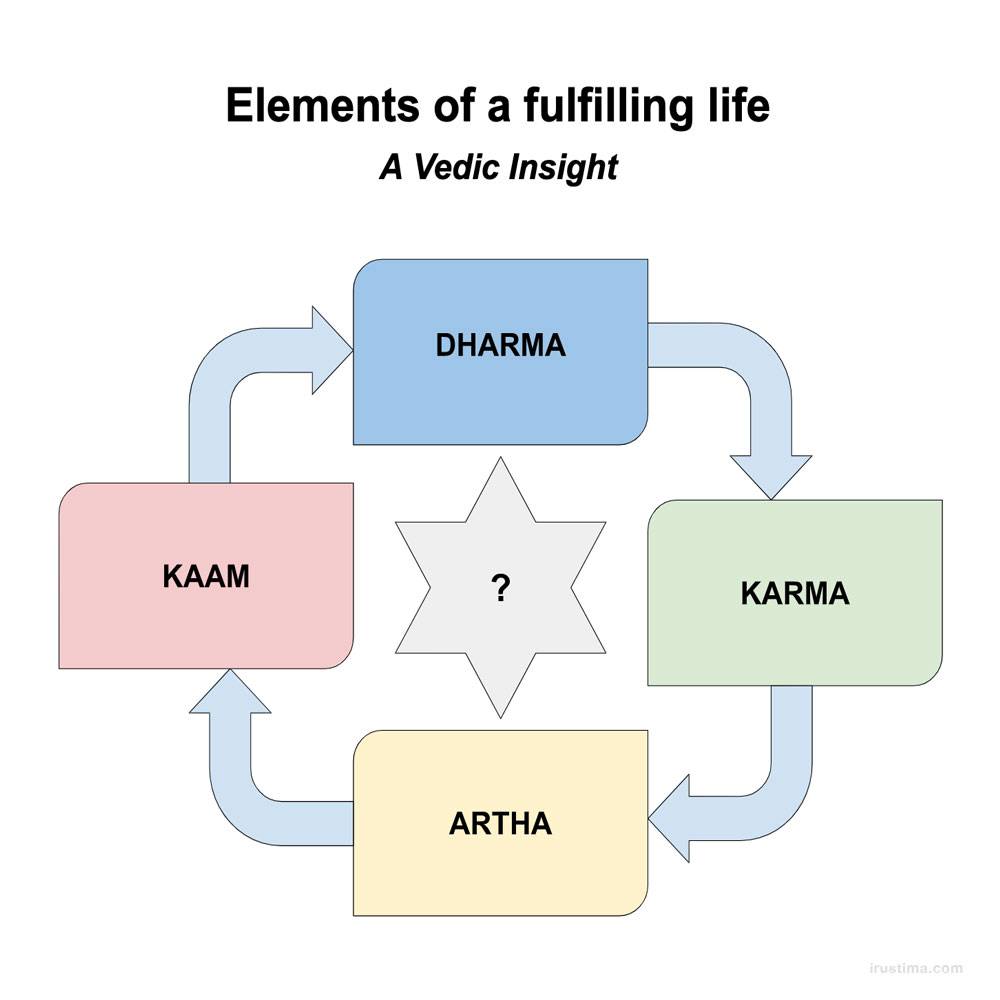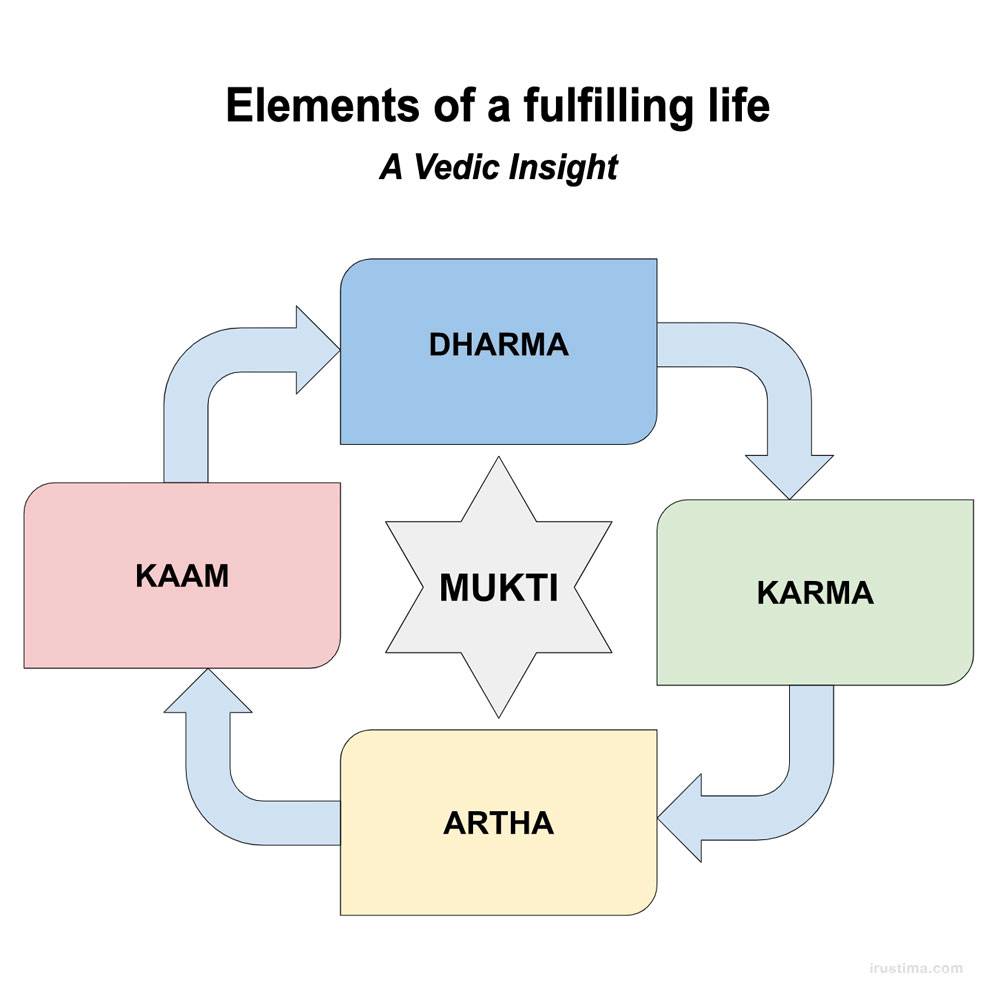
20 Nov Elements of a fulfilling life
Before the 18th century, when Indian scriptures were anglicised under the influence of European and Islamic interpretations of religion, and prior to the forced conversions that took place during Aurganzeb’s reign of terror in the 17th century, the common people of the Indian sub-continent enjoyed a peaceful existence based on the wisdom found in the Vedas, the Upanishads, and the Puranas. Perhaps many even enjoyed the bliss of being alive, despite any wisdom.
Nevertheless, it is humbling to recognise that many religions, such as Hinduism, Jainism, and Buddhism, have emerged from the Vedic scriptures. This serves as evidence that we should shed our misconceptions and acknowledge that there might be something profound in these texts that makes them relevant even today. Each of these religions recognises that there are multiple paths to a fulfilling life or to envisioning a fuller life, and each path is independent among the many plausible alternatives. This is quite interesting given that during the same time, other belief systems were rigid about their own path, and treated any alternative with death.
To this day, despite the diverse population of India with its different paths and religious beliefs, Hinduism, Jainism, Buddhism, Christianity, Islam, Sikhism, Sufism, Zoroastrianism, Paganism, and aestheticism coexist harmoniously. This is probably because the foundation of living in India is still subconsciously rooted in the teachings of the Vedas.
The Vedas contain abundant frameworks for leading a practical and purposeful life. One such framework is living a life guided by Dharma, Karma, Artha, and Kaam, with the ultimate goal, if possible, of achieving Mukti. Let’s delve deeper into each of these elements, and also discover the sixth element which is necessary to enjoy and benefit from the other five.
Dharma – The Rules for Being Righteous
Dharma encompasses the rules for leading a righteous life. A ‘dharmic’ life is lived based on duties, rights, laws, conduct, and virtues. This principle is best exemplified in the epic Ramayana, where the protagonist Lord Rama embodies righteousness by choosing not to use force or exercise his legal rights for personal gain. Why? Because righteousness is the first step toward civility and peace. A righteous person prioritises the well-being of all mankind over personal interests.
Karma – Performing Acts of Responsibility
Karma entails performing acts of responsibility. A karmic life is characterised by taking massive actions, engaging in daily activities, pursuing regular work, and building a long career to make a living and create a better world. Life should be lived by acting in accordance with our beliefs and fulfilling the responsibilities expected of us. This principle finds its best representation in the Mahabharata and the Bhagavad Gita, where the main characters, such as Krishna, Arjuna, Bhishma, and Bheem, take decisive actions, often against their own kin, without concern for the consequences.
Artha – Meaning and Money
Artha represents both meaning and money. In Sanskrit, the word Artha signifies wealth, financial security, and economic prosperity. Humans, unlike animals, live not only for food and shelter but also for growth, prosperity, and civilisation. Artha provides the reason and means to sustain life and humanity, ensuring the abundance of one’s potential and resources.
Kaam – The Pursuit of Pleasure
Kaam is the pursuit of pleasure. A kaamic life is driven by desires, wishes, passions, emotions, and the enjoyment of life’s aesthetic aspects. It encompasses affection, love, and the pleasures of the senses, with or without lustful connotations. With Dharma, Karma, and Artha in order, one is prepared to explore Kaam—the pleasures of human life. Often, many of us are tempted by Kaam and take shortcuts on our journey that should be traveled through righteousness (Dharma), taking massive actions (Karma), and achieving financial independence (Artha), in order to indulge in the state of Kaam (pleasures and enjoyment). However, Kaam attained by forsaking any of the three elements—Dharma, Karma, or Artha—is ultimately illusory, a deception that compromises one’s self-respect.
Mukti – Freedom
Mukti represents freedom. A life lived with righteousness, taking massive actions, abundant resources, and the pursuit of pleasure eventually leads to Mukti, which is liberation from suffering, hardships, sorrow, pain, ailments, relationships, and struggles. According to the Vedas, unlike the concepts of heaven or hell that await us after death, there is no greater reward than Mukti, and it can be attained even while alive. When we excel in Dharma, Karma, Artha, and Kaam, we experience a heavenly existence while still in this world. If we fail to realise our potential in any of these elements, we are given another chance through rebirth—to be born afresh and walk the path of life all over again—until we learn and earn our passage to Mukti.
Tripti – Satisfaction
‘Tripti’ is a beautiful and meaningful Hindi word that embodies the essence of ‘satisfaction’. Derived from ‘tript’, which means ‘satisfied’, Tripti reflects a state of contentment and fulfillment in every aspect of Dharm, Karm, Arth, Kaam and Mukti. This profound term goes beyond momentary happiness, delving into a deep sense of ongoing inner peace and gratification across the entire spectrum. It encapsulates the idea of finding joy and completeness in life’s simple pleasures, fostering a positive outlook and appreciation for the present moment. Embodying the spirit of Tripti allows one to embrace life’s purposes with equanimity and cherish the abundance of experiences that come our way.
In Summary…
Whether our life is a linear journey from birth to death or a cycle of rebirths, it is determined by how well and in what order we prioritise Dharma, Karma, Artha, and Kaam. While at it we maintain a state of satisfaction with everything. When the pursuit of living a fulfilling life is left incomplete or unsatisfactory, death is not the end. We are born again and again in a cycle of rebirths until Mukti is truly earned. In each life, until Mukti is attained, the quality and nature of the life form are determined by the karma of the previous life, and Tripti of the current one.
In this land of thoughtfulness and philosophy, there are well-defined and time-tested Standard Operating Procedures (SOPs) for living life and achieving or earning Mukti. Tripti however is a personal goal, boundless and pathless, and is perhaps very important, irrespective of whether Moksha is attained or not.
P.S.: Mukti is often erroneously considered the same as Moksha, Nirvana, Salvation and Freedom, which it is not. Semantics simplified, in my opinion, is knowledge killed, is wisdom withered. Read here on Mukti, Moksha, Nirvana, Salvation, Freedom.

My sincere thanks to Venki (Payments professional and an Indian culture enthusiast) for editing the article, and saving me the embarrassment of the many language mistakes (spelling and grammar) I had made.
If you liked this post, then you may consider reading The Role of “Maya” in Negotiation, The General Theory on Fitness , The General Theory on Finance , and Creating A Personal ‘Learning Ecosystem’ also.



No Comments